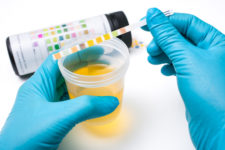 Urinalysis via Shutterstock
Urinalysis via Shutterstock
One of the hallmarks of aging — even in healthy individuals — is a decrease in the body's ability to regulate hydration.If the body doesn't have enough water - dehydrated - then the ions and proteins in the blood and tissues will be too concentrated to work properly. Conversely, too much water dilutes the blood and can be problematic too. The body monitors the level of hydration — too much water and the excess is excreted in the urine. If there's too little, the kidneys decrease the water they excrete, and the urine is more concentrated, darker, and the person will be thirsty and want to drink. At least, that's how it works in young adults.
But in the older individual, the kidneys may not be up to the task, or a variety of health conditions or medications might impair the body's ability to monitor and respond to hydration status. Thus it is important to know how an older person is doing — are they drinking enough but not too much? Typically, in the absence of other reasons to take a blood sample, the hydration status may be monitored by various tests on their urine. These tests are easy to do, are non-invasive, and well-understood. But a recent study sheds doubt on the utility of urine tests — at least in older individuals.
The point of such tests is not just to determine the status of the urine, but to indirectly assess what's happening to the blood and body tissues. There are several tests that can be done — urine color can be assessed, the volume of urine produced over a specified period of time, or measurement of entities such as specific gravity1 or osmolality2.
In a recent edition of The American Journal of Clinical Nutrition, Dr. Lee Hooper from Norwich Medical School, University of East Anglia, Norwich, United Kingdom, reported on their assessment of such urine tests in older adults. Dr. Hooper and colleagues studied people aged 65 years and older who were participants in one of two studies. One study (Dehydration Recognition In our Elders or DRIE) examined the status of individuals in managed care, while the other (NU-AGE, or Dietary Strategies for Healthy Ageing in Europe) involved participants who lived in their communities.
Of the first group of 162 individuals whose mean age was 86 years, 19 percent were dehydrated, according to their serum osmolality measures. In the community-dwelling group (151 individuals with an average age 70 years), 22 percent were dehydrated, according to the serum measurement. In neither group were the urine tests useful predictors of the serum concentration. Thus, a person might be evaluated as normally hydrated according to the status of their urine tests, but actually be at risk of dehydration. This could be especially important to correct during periods of hot weather.
The authors conclude that there "is a need to develop simple, inexpensive, and noninvasive tools for the assessment of dehydration in older people." Until such a tool exists, individuals and their caregivers must be aware of the possibility of dehydration, especially when dealing with persons whose health status is fragile.
1. Urine specific gravity: a ratio of the density of the urine compared to the density of water. Normal values in adults range from 1.003 to 1.030.
2. Osmolality: a measure of the concentration of a solute in a solution in terms of the amount of substance in a specified amount of mass of the solvent. In the urine or blood, this would be the mass of the solute per mass of the liquid portion of the blood or urine.
